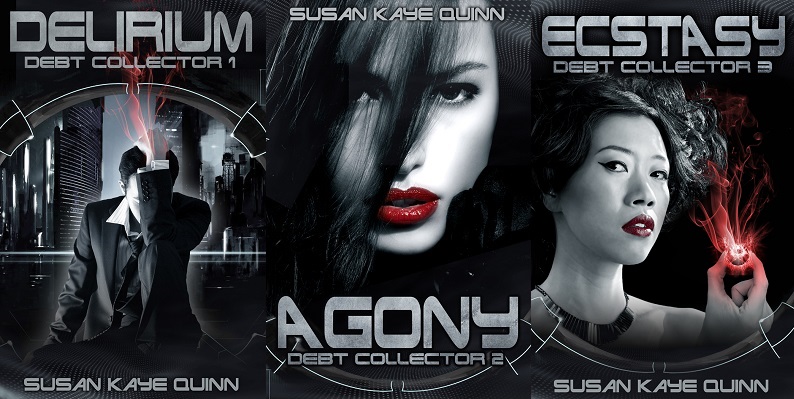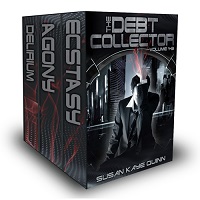Today and Wednesday, I’m interviewing Susan Kaye Quinn – a critique partner of mine – on her new gritty science-fiction series, THE DEBT COLLECTOR, which is being written and published in the format of an old-time serial.
First, an author bio:
Susan Kaye Quinn is the author of the bestselling YA SF Mindjackseries. Her new Debt Collectorserial is her more grown-up SF. Her steampunk fantasy romance is temporarily on hold while she madly writes episodes to keep Lirium (the titular Debt Collector) happy. Plus she needs to leave time to play on Facebook. Susan has a lot of degrees in engineering, which come in handy when dreaming up dangerous mind powers, future dystopias, and slightly plausible steampunk inventions. Mostly she sits around in her pajamas in awe that she gets make stuff up full-time. You can find her at www.susankayequinn.com
Now the first part of our interview …
1. Why is NOW the right time for “The Return of the Serial?”
Ebooks have reduced the cost of delivery of written works to zero – anything from a short story to a G.R.R. Martin novel is the same cost. At the same time, indie publishing has freed writers to experiment with form (short stories, anthologies, serials) without having to worry if a publisher will find it worth investing in for a print-run. The public is used to serialized storytelling in TV form – with a wide range from formula-driven stories like Law&Order to high-concept, almost novel-like stories like Lost.
Meanwhile, novels have been getting more cinematic, with blockbusters like Hunger Games actually written by people with screenwriting backgrounds. And then there’s the fan-author connection, which has been vastly increased by social media and the advent of ebooks and indie publishing, reinforcing the incentive for writers to produce works quickly for eagerly waiting fans. The stratospheric success of indie serial Wool, by Hugh Howey, definitively showed readers care about story not format or publication path. All of that adds up to a fertile environment for serials, where satisfying story nuggets (episodes) are produced quickly, delivered cheaply, and provide a social entertainment experience more like Must Read TV than immersion novel reading.
I truly believe we’re entering an age of fan-driven art – where the connection between the artist and the consumer of the art is immediate, visceral, and drives the art that is produced. The recent (massive) success of kickstarter campaigns to fund fan-favorites, like the RPG game Torment or the Veronica Mars movie, show how this can happen at the millions-of-dollars level, but all kinds of art (music, books, games, movies) is being funded at smaller levels by fan enthusiasm. This is not to say that all fan-driven art will be remakes or extensions of favorites like Veronica Mars. Wool was a new concept that fans loved and drove to stardom. It’s still up to the artist to create something new and awesome. But consumers of said art – rather than tastemakers like reviewers and publishers – are now driving which art becomes commercially successful (at large and small scales). Readers see something they like and say, Yes! More of that, please, and writers have the ability to respond. Serials fit this bottom-up model of art creation that I believe is just going to get stronger in the future.
2. The premise of The Debt Collector just floored me. When you owe more than your life is worth, your life force is “collected” and given to someone who, presumably is worth more. Where did the inspiration come from?
Inspiration is always a collection of things (books, movies, news, life) that you stuff into your subconscious, stir around, and see what pops out. In this case, I had a long drive in the car alone and decided to brainstorm a new story. I was mostly killing time. (Ha! Killing time! That subconscious is a tricky devil.) The idea of writing an anti-hero story had been niggling my brain for a while, so I focused on that. In retrospect, I think movies like Looper and In Time had been stuffed in there, along with the fact that the economy stinks, the country is massively in debt, several local businesses in my area had recently gone under, and my mom had cancer last year. She beat back the cancer, but she’s still facing the mountain of debt that goes along with serious illness. Consciously, none of that was in my head. What actually happened in the car went something like this:
Muse: The Debt Collector.
Me: Er, what? Who are you?
Muse: When people’s debts exceed their future potential contributions to society, he cashes them out.
Me: Whoa. Tell me more.
Muse: He extracts their life energy and transfers it to a “high potential” – someone who can use it to make greater contributions to the world.
Me: Holy Crap. That’s a great idea.
Muse: He’s a good man with bad power. And it’s future-noir.
Me: Future-noir! Cool! Uh, what is that exactly?
Muse: Dark. Gritty. Futuristic but retro at the same time.
Me: Oh… like Blade Runner… Holy Crap, this is awesome.
Muse: You’re welcome.
Okay, Susan’s interview is such awesome stuff (as is this serial) that I had to stop here and stretch it out a bit. Please return on Wednesday to read the rest of this interview … starting with what happened when real life debt collectors stumbled across her series.
In the meantime, you can win a copy of Episode 1: DELIRIUM. Enter via Rafflecopter below: a Rafflecopter giveaway




Great interview! (Well, half-interview–I’m looking forward to the rest of it.) The Debt Collector sounds fantastic. 🙂
Great interview. Can’t wait to hear what real debt collectors thought, especially since as an attorney I deal with them all the time for my clients.
I read the first installment of this series and loved it. It was really a page turner and I loved that the story is told from a male POV. Can’t wait to read the rest in between my books for my blog interviews.
@LindaG Thanks!
@Natalie Thanks for getting Delirium (DC1)!! I’m so glad you enjoyed it. I really love writing male POV, and was glad to get back to it again!
And Dianne – *hugs* – You’re the best for all your (amazing) critiques and for hosting me this week!
Definitely a very interesting premise! Isn’t it nice when our muse stops by and gives us something really cool 🙂
Awesome interview! And I love TDC’s premise! Your muse deserves to be taken out to dinner for that one Susan:) lol
These are some of the best stories I’ve read in a while.
@MSHATCH I’d thank my Muse but I don’t want her to get uppity on me. 😉
@CQG Thanks! I need to be careful when I let the Muse out – she tends to rip up all my writing plans and say write this instead. 🙂
@Matt *blushes*
Those covers are striking with that little bit of red.
Thanks Donna! Steven Novak does a great job with my covers! 🙂
Sounds like a fascinating new series. Go Susan!